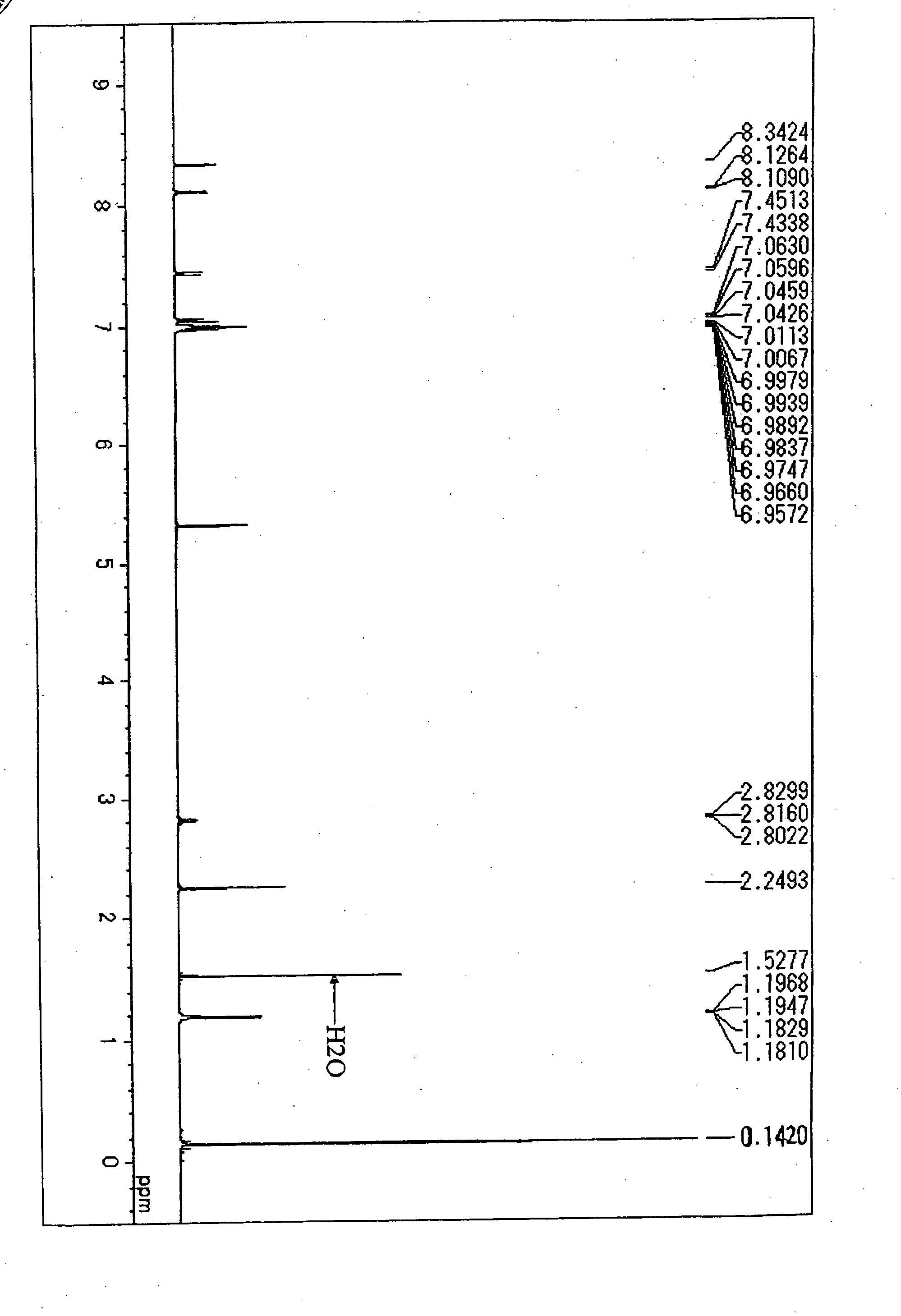Aromatic amine derivative and organic electroluminescence device employing the same
a technology of organic electroluminescence and amine derivative, which is applied in the direction of discharge tube luminescnet screen, discharge tube/lamp details, organic chemistry, etc., can solve the problems of insufficient efficiency of light emission and lifetime, failure to show a sufficiently long lifetime, and insufficient luminance, etc., to achieve sufficient luminance and enhance light emission efficiency
- Summary
- Abstract
- Description
- Claims
- Application Information
AI Technical Summary
Benefits of technology
Problems solved by technology
Method used
Image
Examples
synthesis example 1
Synthesis of Compound (D-3-2)
(1) Synthesis of 2,6-bis(trimethylsilyl)anthracene
[0089] Under an atmospheric argon gas flow, 2,6-dibromoanthracene in an amount of 2.8 g (8.3 millimole), dried tetrahydrofuran (THF) in an amount of 200 milliliter and dried toluene in an amount of 200 milliliter were placed into a three necked-flask equipped with a cooling pipe and having a capacity of 1 liter and then, the resultant solution was cooled down to −30° C. Subsequently, n-butyllithium in an amount of 12 milliliter (19.1 millimole, 1.58 M hexane solution) was added slowly. Then, after adding trimethylsilylchloride in an amount of 2.4 milliliter (19.1 millimole, d=0.85) at a temperature of −70° C., the resultant solution was stirred at a room temperature for 1 hour. After completing the reaction, 100 milliliter of water was added and an organic layer was separated. The solution was dried with a use of sodium sulfate and then, the solvent was separated by distillation, and the residue was was...
example 1
[0092] A 130 nanometer-thick transparent electrode made of indium tin oxide was formed on a glass substrate having a size of 25 mm×75 mm×1.1 mm. The glass substrate with the transparent electrode was cleaned by irradiation of ultraviolet ray and ozone. The thus cleaned glass substrate with the transparent electrode was mounted to a vacuum vapor deposition apparatus.
[0093] First, N′,N″-bis[4-(diphenylamino)phenyl]-N′,N″-diphenylbiphenyl-4,4′-diamine was vapor-deposited to form a hole injecting layer having a thickness of 60 nanometers, and then N,N,N′,N′-tetrakis(4-biphenyl)-4,4′-benzidine was vapor-deposited on the hole injecting layer to form a hole transporting layer having a thickness of 20 nanometers. Then, 10,10′-bis[1,1′,4′,1″]terphenyl-2-yl-9,9′-bianthracenyl and the foregoing Compound (D-1-5) as a doping material were simultaneously vapor-deposited at a weight ratio of 40:2 on the hole transporting layer to form a light emitting layer having a thickness of 40 nanometers.
[0...
example 2
[0096] An organic EL device was fabricated in accordance with the same procedures as those conducted in Example 1 except that Compound (D-1-5) was replaced with Compound (D-3-1) as the doping material.
[0097] As a result of subjecting the organic EL device to a test by feeding electric current, it was confirmed that a green light with a luminance of 1400 cd / m2 (peak wavelength of light emission: 540 nanometers) and current efficiency of 14 cd / A was emitted at a voltage of 6.5 V and a current density of 10 mA / cm2. Further, as a result of subjecting the device to a continuous test by feeding DC electric current starting at an initial luminance of 1,000 cd / m2, it was confirmed that the half lifetime thereof was 20,000 hours or longer, which was within a sufficiently practical range.
PUM
| Property | Measurement | Unit |
|---|---|---|
| work function | aaaaa | aaaaa |
| light transmittance | aaaaa | aaaaa |
| thickness | aaaaa | aaaaa |
Abstract
Description
Claims
Application Information
 Login to View More
Login to View More - R&D
- Intellectual Property
- Life Sciences
- Materials
- Tech Scout
- Unparalleled Data Quality
- Higher Quality Content
- 60% Fewer Hallucinations
Browse by: Latest US Patents, China's latest patents, Technical Efficacy Thesaurus, Application Domain, Technology Topic, Popular Technical Reports.
© 2025 PatSnap. All rights reserved.Legal|Privacy policy|Modern Slavery Act Transparency Statement|Sitemap|About US| Contact US: help@patsnap.com



